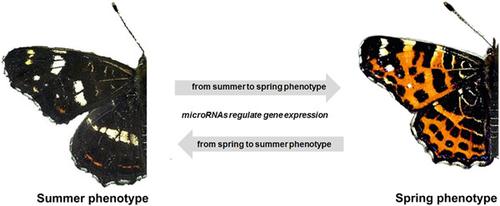当前位置:
X-MOL 学术
›
Arch. Insect Biochem. Physiol.
›
论文详情
Our official English website, www.x-mol.net, welcomes your
feedback! (Note: you will need to create a separate account there.)
Seasonal phenotype-specific expression of microRNAs during metamorphosis in the European map butterfly Araschnia levana.
Archives of Insect Biochemistry and Physiology ( IF 1.5 ) Pub Date : 2020-01-21 , DOI: 10.1002/arch.21657 Krishnendu Mukherjee 1 , Arne Baudach 2 , Heiko Vogel 3 , Andreas Vilcinskas 1, 2
Archives of Insect Biochemistry and Physiology ( IF 1.5 ) Pub Date : 2020-01-21 , DOI: 10.1002/arch.21657 Krishnendu Mukherjee 1 , Arne Baudach 2 , Heiko Vogel 3 , Andreas Vilcinskas 1, 2
Affiliation

|
The European map butterfly (Araschnia levana) is a well‐known example of seasonal polyphenism because the spring and summer imagoes exhibit distinct morphological phenotypes. The day length and temperature during larval and prepupal development determine whether spring or summer imagoes emerge after metamorphosis. Inspired by the fundamentally different transcriptomic profiles in prepupae developing from larvae exposed to long days or short days, we postulate that posttranscriptional epigenetic regulators such as microRNAs (miRNAs) may contribute to the epigenetic control of seasonal polyphenism in A. levana. To test this hypothesis, we used microarrays containing over 2,000 insect miRNAs to identify candidate regulators that are differentially expressed in last‐instar larvae or pupae developing under long‐day or short‐day conditions. We used our transcriptomic database to identify potential 3′‐untranslated regions of messenger RNAs to predict miRNA targets by considering both base pair complementarity and minimum free energy hybridization. This approach resulted in the identification of multiple targets of miRNAs that were differentially regulated in polyphenic morphs of A. levana including a candidate (miR‐2856‐3p) regulating the previously identified diapause bioclock protein gene. In conclusion, the expression profiling of miRNAs provided insights into their possible involvement in seasonal polyphenism of A. levana and offer an important resource for further studies.
中文翻译:

在欧洲地图蝴蝶Araschnia levana的变态过程中,microRNA的季节性表型特异性表达。
欧洲地图上的蝴蝶(Araschnia levana)是季节性多态性的一个著名例子,因为春季和夏季的成虫表现出不同的形态表型。幼虫和pu的发育过程中的日长和温度决定了变态后出现春季或夏季的成虫。受暴露于长日或短日幼虫的幼虫发育过程中转录组学原理的根本不同的启发,我们推测转录后表观遗传调控因子(例如microRNA(miRNA))可能有助于对拟南芥中季节性多态性的表观遗传控制。。为了验证这一假设,我们使用了包含2,000多种昆虫miRNA的微阵列,以鉴定在长日或短日条件下发育的最后一龄幼虫或p中差异表达的候选调控因子。我们使用转录组数据库,通过考虑碱基对的互补性和最小的自由能杂交来确定信使RNA的潜在3'非翻译区,从而预测miRNA靶标。这种方法导致的该被差异在polyphenic变种调节的miRNA的多个靶的鉴定A. levana包括调节所述先前确定的滞育bioclock蛋白基因的候选(MIR-2856-3p)。总之,miRNA的表达谱提供了对其可能参与季节性季节性多态性的见解。A. levana并提供了进一步研究的重要资源。
更新日期:2020-01-21
中文翻译:

在欧洲地图蝴蝶Araschnia levana的变态过程中,microRNA的季节性表型特异性表达。
欧洲地图上的蝴蝶(Araschnia levana)是季节性多态性的一个著名例子,因为春季和夏季的成虫表现出不同的形态表型。幼虫和pu的发育过程中的日长和温度决定了变态后出现春季或夏季的成虫。受暴露于长日或短日幼虫的幼虫发育过程中转录组学原理的根本不同的启发,我们推测转录后表观遗传调控因子(例如microRNA(miRNA))可能有助于对拟南芥中季节性多态性的表观遗传控制。。为了验证这一假设,我们使用了包含2,000多种昆虫miRNA的微阵列,以鉴定在长日或短日条件下发育的最后一龄幼虫或p中差异表达的候选调控因子。我们使用转录组数据库,通过考虑碱基对的互补性和最小的自由能杂交来确定信使RNA的潜在3'非翻译区,从而预测miRNA靶标。这种方法导致的该被差异在polyphenic变种调节的miRNA的多个靶的鉴定A. levana包括调节所述先前确定的滞育bioclock蛋白基因的候选(MIR-2856-3p)。总之,miRNA的表达谱提供了对其可能参与季节性季节性多态性的见解。A. levana并提供了进一步研究的重要资源。











































 京公网安备 11010802027423号
京公网安备 11010802027423号